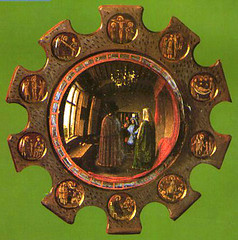Today's technique of oil painting was established circa 1410 by Jan van Eyck, says Wikipedia.
Though van Eyck was not the first to use oil paint, he was the first artist to have produced a siccative oil mixture which could be used to combine mineral pigments. Van Eyck’s mixture may have consisted of piled glass, calcined bones, and mineral pigments boiled in linseed oil until reaching a viscous state. Or he may have simply used Sun-thickened oils (slightly oxidized by Sun exposure). He left no written statement.
Antonello da Messina later improved oil paint: he added lead (II) oxide. The new mixture had a honey-like consistency and increased drying properties. This mixture was known as oglio cotto—"cooked oil."
Leonardo da Vinci later improved these techniques by cooking the mixture at a very low temperature and adding 5 to 10% beeswax, which prevented darkening of the paint. Giorgione, Titian, and Tintoretto each may have altered this recipe for their own purposes.
The advantage of the slow-drying quality of oil paint is that an artist can develop a painting leisurely.
Earlier media such as egg tempera dried quickly, which prevented the artist from making changes or corrections. With oil-based paints, revising was comparatively easy. The disadvantage is that a painting might take months or years to finish, which might disappoint an anxious patron. Oil paints also blend well with each other, making subtle variations of color possible as well as more easily creating details of light and shadow.
Oil paints can be diluted with turpentine or other thinning agents which allowed an artist to build a painting in layers, however, such agents are highly flammable and the danger of a studio fire was always present.
Another danger to artists as they mix their paints is the toxicity of the pigments - ex: lead, now most often replaced by less toxic zinc and titanium, and the red to yellow cadmium pigments.
Subscribe to:
Post Comments (Atom)





No comments:
Post a Comment